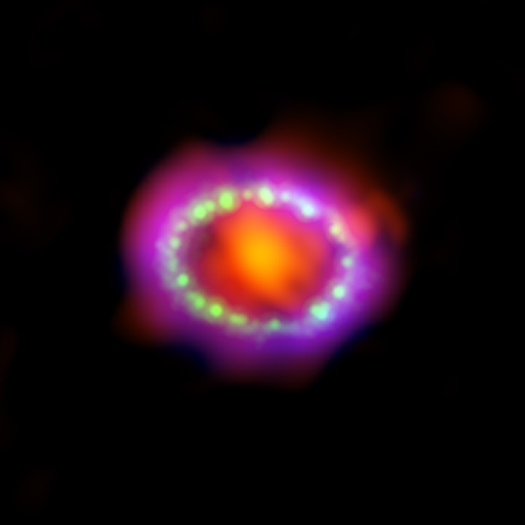

To celebrate 30 years since Supernova 1987A was spotted, a new composite image shows the most recent images of the object, and contains X-rays from NASA's Chandra X-ray Observatory (blue), visible light data from NASA's Hubble Space Telescope (green), and submillimeter wavelength data from the international Atacama Large Millimeter/submillimeter Array (ALMA) telescope in Chile (red).
30 years ago today, a supernova explosion was spotted in the southern hemisphere skies. The exploding star was located in the Large Magellanic Cloud — a satellite galaxy of the Milky Way – and Supernova 1987A was the brightest and nearest supernova explosion for modern astronomers to observe. This has provided an amazing opportunity to study the death of a star.
Telescopes around the world and in space have been keeping an eye on this event, and the latest images show the blast wave from the original explosion is still expanding, and it has plowed into a ring expelled by the pre-supernova star. The latest images and data reveal the blast is now moving past the ring.
Got a 3-D printer? You can print out your own version of SN1987A! Find the plans here.
Below is the latest image of this supernova, as seen by the Hubble Space Telescope. You can see it in the center of the image among a backdrop of stars, and the supernova is surrounded by gas clouds.
Hubble launched in 1990, just three years after the supernova was detected, so Hubble has a long history of observations. In addition, the Chandra X-ray telescope – launched in 1999 – has been keeping an eye on the explosion too.
Here are a few animations and images of SN1987A over the years:
Here’s a link to the original astronomer’s telegram announcing the detection.
Astronomers estimate that the ring material was was ejected about 20,000 years before the actual explosion took place. Then, the initial blast of light from the supernova illuminated the rings. They slowly faded over the first decade after the explosion, until the shock wave of the supernova slammed into the inner ring in 2001, heating the gas to searing temperatures and generating strong X-ray emission.
The observations by Hubble, Chandra and telescopes around the world has shed light on how supernovae can affect the dynamics and chemistry of their surrounding environment, and continue to shape galactic evolution.
See additional images and animations at the Chandra website, ESA’s Hubble website , and NASA.
How can we explore Saturn’s moon, Enceladus, to include its surface and subsurface ocean, with…
Have you ever wondered how astronomers manage to map out the Milky Way when it's…
NASA astronomers have been continuing to monitor the trajectory of asteroid 2024 YR4. The initial…
Some exoplanets have characteristics totally alien to our Solar System. Hot Jupiters are one such…
Stars form in Giant Molecular Clouds (GMCs), vast clouds of mostly hydrogen that can span…
Let’s dive into one of those cosmic curiosities that's bound to blow your mind: how…